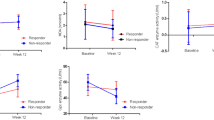Abstract
Susceptibility of Schizophrenic patients to lipid peroxidation relative to healthy control subjects was investigated by measuring the malondialdehyde (MDA) levels in plasma. The main finding was that Schizophrenic patients were more susceptible than control subjects to oxidative damage as evident from increased MDA levels in plasma. Antioxidant levels are also depleted in Schizophrenic patients when compared to normal subjects as evident from decreased levels of vitamins E and C in the plasma. Impaired antioxidant defense and increased lipid peroxidation suggests that treatment with antioxidants (Vitamin E, Vitamin C, beta carotene) at the initial stages of illness may prevent further oxidative injury and deterioration of associated neurological deficits in Schizophrenia.
Similar content being viewed by others
References
Fantone, JC. and Ward, P.A. (1982) Role of oxygen derived free radicals and metabolites in leukocyte dependent inflammatory reactions. Am. J. Pathol. 107, 397–418.
Mylonas, C. and Kouretas, D. (1999) Lipid peroxidation and tissue damage. In Vivo 13, 295.
Gupta, V.K., Mallika, V., Yashika Gupta. and Srivastav, D.K. (1992) Oxygen derived free radicals in clinical context. Ind. J. Clin. Biochem 7, 3–10.
Rosly, IM., Romm, AR., Azizova, O.A. and Vladimirov, Iu. A. (1990) Lipid peroxidation in the blood of patients in suppurative meningitis. Pathol. Fiziol. Eksp. Ter. 4, 40–41.
Halliwell, B. and Gutteridge, J.M.C. (1991) Free radicals and toxicology. In: Free radicals in biology and medicine. Eds. Halliwell B & Gutteridge, J M C., Clarendon Press, Oxford. p 299–365.
Ratan, R.R. and Baraban, J.M. (1995) Apoptotic death in anin vitro model of neuronal oxidative stress. Clin. Exp. Pharmacol. Physiol. 22, 309–310.
Mecocci, P., Mac Garvey, V., Kaufman, A E, Koontz, D., Shoffner, J.M. and Wallace, DC. (1993) The oxidative damage to mitochondrial DNA shows age dependent increase in human brain. Ann. Neurol. 34, 159–163.
Schapera, A.H. and Cooper, J.M. (1992) Mitochondrial function in neurodegeneration and ageing. Mutat. Res. 275, 133–143.
Graham, DG. (1978) Oxidative path way for catecholamines in the genesis of neuromelanin and cytotoxic quinines. Mol. Pharmacol. 14, 633–643.
Eliot Slater and Martin Roth (1986) Schizophrenia. In: Clinical Psychiatry, 3 rd Edition, Cassel Ltd, 35, Red Lion Square, London, p 237–258.
Niraj Ahuja (1999) Schizophrenia. In: A Text book of Psychiatry, 4th Edition, Jaypee Brothers Medical publishers Pvt. Ltd, New Delhi, p 51–55.
Mahadik, S.P. and Scheffer, R E. (1996) Oxidative injury and potential use of antioxidants in Schizophrenia. Prostaglandins Leukot. Essent. Fatty acids, 55, 45–54.
Satoh, K. (1978) Serum lipid perxide in cerebrovascular disorders determined by new colorimetric method. Clin. Chim. Acta, 90, 37–43.
Stocks, J. and Doromondy, T L. (1971) The auto oxidation of human red cell lipids induced by hydrogen peroxide. Br. J. Haematol. 20, 95–111.
Bieri, J G., Teets, L. Belavady, B. and Andrews, E.L. (1964) Serum vitamin E levels in a normal adult population in the Washington D.C. area. Proc. Soc. Exptl. Biol. Med. 117, 131–133.
Teitz, N.W. (1986) Methods of determination of ascorbic acid. In: Text Book of Clinical Chemistry, Edited by N.W. Teitz, W B Saunders Company Philadelphia, London, Toronto, p. 960–962.
Schroeder, D.J., Hart, L.L. and Miyagi, SL. (1993) Vitamin E in Tardive dyskinesia. Ann. Pharmacother. 27, 311.
Adler, L.A., Peselow, E. and Duncann, E. (1993) Vitamin E in Tardive dyskinesia: time course of effect after placebo substitution. Pharmacol Bull. 27, 371–374.
Mahadik, S P. and Mukherjee, S. (1996) Elevated plasma lipid peroxides at the onset of non-effective psychosis. Schizophr. Res. 19, 1–7.
Glenberg, A.J., Bassuk, E.L. and Schoonover, S. (1991) The Practitioner's guide to psycho active drugs, New York, Plenum Publishing Co., p 143–153.
Sudha, K., Rao, A.V. and Rao, A. (2001) Oxidative stress and antioxidants in epilepsy. Clin. Chim. Acta. 303, 19–24.
Author information
Authors and Affiliations
Rights and permissions
About this article
Cite this article
D'Souza, B., D'Souza, V. Oxidative injury and antioxidant vitamins E and C in Schizophrenia. Indian J Clin Biochem 18, 87–90 (2003). https://doi.org/10.1007/BF02867671
Issue Date:
DOI: https://doi.org/10.1007/BF02867671




